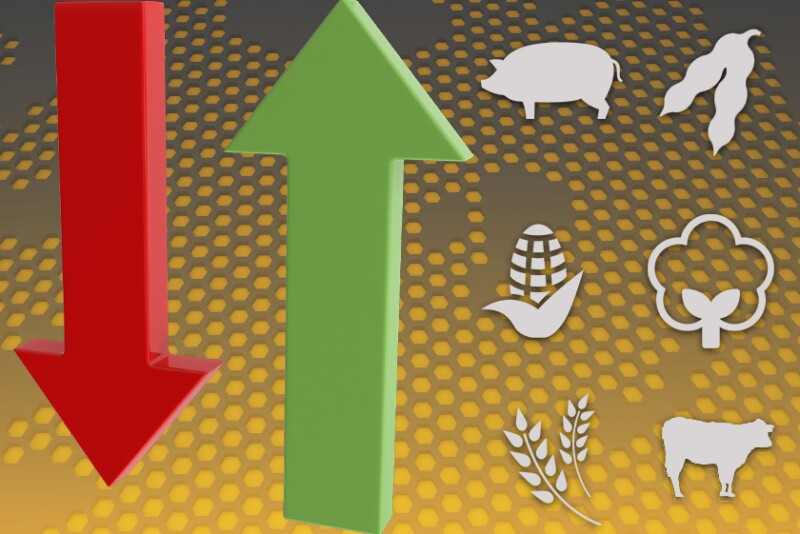GRAIN CALLS
Corn: 2 to 6 cents higher.
Soybeans: 9 to 12 cents lower.
Wheat: 2 to 10 cents higher.
GENERAL COMMENTS:
Corn futures rose in overnight trading following a three-day losing streak driven by expectations that cooler, wetter weather forecast for the U.S. Midwest will relieve stress on crops. Soybean futures fell to the lowest levels in nearly three weeks on crop-friendlier weather and a weaker-than-expected NOPA crush figure for May. Spring wheat led overnight gains in the wheat markets. Crude oil futures hit 2 1/2-year high near $73 a barrel.
Milder weather and rainfall are in store for much of the U.S. Plains and Midwest this weekend and next week, according to World Weather Inc., which had few significant changes to its outlook early today. Some weather models called for increased rainfall from southeastern South Dakota through northern Iowa, to about 0.50 to 2 inches. Most models indicate rains will be best over southern and eastern areas of the Corn Belt, with northern and western locations likely to see the smallest amounts.
The Biden administration is developing targets for biofuels that are likely to be relatively flat or even lower as it seeks to balance the interests of blue-collar refining workers and advance a clean-energy agenda, Bloomberg reported. EPA is set to propose renewable fuel requirements within weeks. The volume requirements will dictate how much corn-based ethanol, biodiesel and other renewable fuels oil refiners must blend into their products in 2021 and 2022. The proposal is on track to be issued after the Supreme Court makes what could be a pivotal ruling on the EPA’s ability to exempt refineries from the mandates.
Russia, Ukraine and Kazakhstan will likely export 66 MMT of wheat during the 2021-22 marketing year beginning July 1, a 5% rise from the previous season, according to analysts polled by Reuters. The higher export forecast comes despite forecasts for combined wheat production to fall 1% to 124 MMT, and expectations for tougher competition out of the European Union. Russia is expected to remain the world’s biggest wheat exporter, but the floating export tax regime presents challenges for traders.
In overnight export news, Egypt canceled its tender to buy an unspecified amount of wheat in a global tender. South Korea’s Korea Feed Association bought an estimated 60,000 MT of corn from South America in a private deal. Japan’s ag ministry says it received no offers in its simultaneous buy and sell auction where it was seeking 80,000 MT of feed wheat and 100,000 MT of feed barley.
USDA announced a daily sale of 153,416 MT of corn to unknown destinations for 2021-22 delivery. That’s the first daily corn sale since May 27.
CORN:
Futures posted a modest overnight bounce from a three-day sell-off that sent prices to two-week lows. Rain projected for the Midwest over the next week should help improve crop conditions, but more moisture is needed for critical growing stages the remainder of summer.
SOYBEANS:
Demand concerns continued to weigh on soybean futures after NOPA yesterday reported a lower-than- expected crush figure for May, the fourth consecutive month crush failed to meet trade expectations. To reach USDA’s old-crop crush forecast of 2.175 billion bu., the crush pace over the final three months of 2020-21 must total 531 million bu., down 5 million bu. from the same period last year. November soybeans overnight fell as low as $13.47 1/2, the contract’s lowest price since $13.37 1/4 on May 27.
WHEAT:
Wheat futures may continue to look to corn for price direction, though upside will likely be limited as winter wheat harvest accelerates. Weather forecasts for U.S. wheat country are mostly favorable for harvest the next two weeks. As of Sunday, USDA reported 4% of the U.S. winter wheat crop was harvested, which is 11 points behind the five-year average.
CATTLE: Steady-firmer
HOGS: Steady-mixed
CATTLE:
Cash markets will remain of keen interest today after live cattle prices jumped yesterday. USDA confirmed some additional, fairly active cash cattle trade between $123 and $124 in Iowa and Nebraska yesterday, and Texas had light trade at $122. Choice cutout values yesterday averaged $334.43, down $1.04 from Monday but up from about $228 a year ago.
HOGS:
Conflicting signals from cash markets early this week may lead to mixed trade in futures amid questions about when hogs will reach a seasonal price peak. National direct carcasses yesterday averaged $122.72, up $5.38 from Monday and up from $105.32 at the end of May, but pork cutout values averaged $122.51, down $6.17, USDA reported. A 6 1/2-month uptrend remains in place on the daily charts.
China’s pig herd surged 23.5% in May compared with the year prior, according to state media, which cited the country’s ag ministry. The country’s sow herd in May was up 19.3% from year-ago, and at 98.4% of levels seen at the close of 2017—before African swine fever (ASF) hit. The average hog-to-grain ratio dropped below 6:1 in China, falling below the level where most farmers make money, the National Development and Reform Commission (NDRC) reported. It issued a level-3 warning about an excessive drop in live hog prices and urged pig farmers to keep production capacity at a reasonable level.

